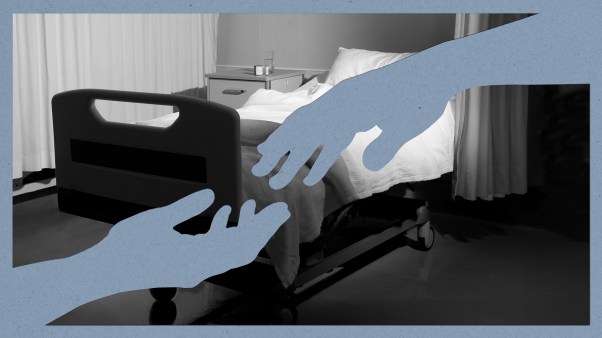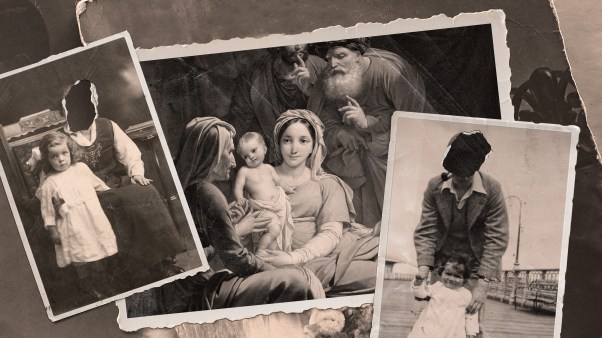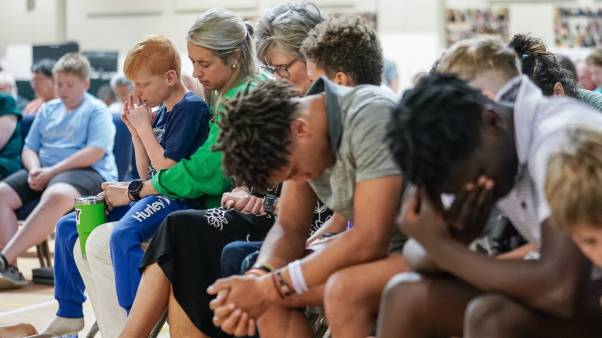It is Sunday morning and quiet throughout our house. The first morning light is slipping through our blinds, just enough for my husband to read his Bible and for me to write. The only thing I hear is our coffee percolating. Sunday mornings are easily the most peaceful time in our otherwise noisy, demanding schedule.
During the pandemic with churches closed, we learned to savor Sunday mornings as especially convivial and serene. After a couple quiet reading hours, my husband, Chris, would prepare breakfast. Our three children would tumble out of bed around 11 to pancakes or waffles, eggs, and bacon. Then Chris and I would head out for a walk around our neighborhood, waving at neighbors. On more ambitious weekends, we’d take to hiking trails.
When struck by convictions about missing church, Chris and I would wake the kids a bit earlier, around 10:30. Though they were only really losing 30 minutes’ sleep, they’d make a grumpy little show of it. We’d file into the living room, sit on our green couches, and take in some spirited preaching by a local megachurch pastor. Megachurches had an advantage during the pandemic, easily pivoting to sleek broadcasts while many smaller churches struggled to improvise.
After the pandemic faded away, though, we found our new routine difficult to break. Attending church in person now feels like a series of sacrifices. We have to wake the children at 9:30 to get them fed, dressed, and out the door on time. All this bustle means Chris and I get less peace, less quiet, less reading, and no leisurely morning walk. It’s 8:09 a.m. now, as I write this. To get to church this morning, I’ll have to stop writing in 30 minutes.
Reader, I don’t want to. I do not want to make these little sacrifices. Sunday mornings are restorative when they are quiet and leisurely. They are good for all of us.
Or so I once thought, but no longer.
The pandemic had far-reaching consequences in our society, especially for young people—including my children. My smallest had her kindergarten year disrupted so that when she finally returned to school in person, she struggled to make friends. My middle child’s online elementary school didn’t prepare her for the very different demands of middle school. And my high schooler spent too much time online, imbibing geopolitics and national news in ways that left him stressed and cynical.
Sundays at home did renew our individual energy and family life. But they also exacerbated our sense of disconnection from community life. Staying in meant we got more and more of our information from screens—which in turn presented the world as increasingly fractious.
By staying home as a family on Sundays, I realized, I was subtly and unintentionally telling my children that the world was too tiresome and too fraught to engage on the weekends. I was modeling the idea that we could retreat, even from life together with fellow Christians.
Our children took note. Initially, they complained that they saw less of our friends, but then they began to communicate a growing distress about public life. They told me their worries about school shootings, the prospect of a military draft, friends moving away, and disagreements within our extended family over politics. For a variety of reasons, each of my children grew more ambivalent about relationships in our family, church, and schools. Our withdrawal from church fed into other kinds of retreat. Looking back, this trajectory seems designed to produce a collective depression.
Upon reflection, the most spiritually formative time in my life bears some similarities to this one.
I was a couple of months shy of twelve years old when my littlest sister died from a heart condition. Shortly after she passed away, my dad built our family a new house. Moving into this house meant that I had to leave my school and church, which were too far from our new neighborhood. When I began seventh grade just a few months later, I was overwhelmed by grief and had no cousins, no church community, and no school friends around to help. I’d never been so profoundly alone before this experience and have never been so since.
Mercifully, we joined Westover Hills, a vibrant, 400-person congregation that embraced our family at the lowest point of our lives. Though our grief felt isolating, we still attended services every Sunday morning and night, and every Wednesday too. Soon, our family life was structured by our church participation. My dad joined the orchestra, my mom, the choir. I joined the youth group and my younger sister, children’s church.
When I look back now, I see my family was hobbling along, doing the best we could under the circumstances. But I also see choir members’ mauve robes with cranberry accents, their arms lifted and eyes closed in worship; deacons with broad shoulders and smiles; friends with cars, picking me up for a Friday youth game night. The people of Westover carried us through the most trying time of our lives with their faithfulness, their voluntary good cheer, their testimonies, and their prayers. They were not just our church but the church, helping us to keep our faith when our hearts were broken. I remain so grateful to them, and I always feel deep down that Westover Hills of the 1990s is the community I am truly from.
Westover came to mind when my husband recently announced that we really need to return to church, in person and for good. No more Sundays on the couch.
We committed to going to the same church we’d been watching online, at least for a while. We couldn’t risk losing momentum by going church shopping. We needed the structure, the regularity of church every Sunday in person. The megachurch would suffice.
This church is 22,000 strong, and in our service, there are about 5,000 people each week. This is a massive number of people. I feel like an ant when we walk in and even more so when we try to walk out, a process that brings the word “stampede” to mind. Two weeks ago, we waited 30 minutes to exit the parking lot.
There are so many little inconveniences in our Sunday mornings now, and they add up—to work. It is work to wrangle everyone, including myself, into the car, into the pew, and then back home again.
But we have a totally different experience of church in our actual pews. Our pastor preaches the same sermon in real time and online, so it isn’t the sermon that’s different. It’s the palpable participation of the congregation that makes the greatest difference.
In person, you can hear and see how the preaching lands with fellow believers. Three weeks ago, I heard a man say, “You better say that again”—emphatically, in a baritone staccato—when our pastor preached a salient point.
Another time, a person directly in front of me spent three minutes intermittently nodding her head in agreement during a section of preaching about surrender. She sat with her smallest girl right next to her, almost in her lap, and three boys right beside them. When our pastor landed a point, she nodded. He repeated or extended an idea, she nodded again. Later, the pastor asked, “How many people here have ever felt they are not worthy of a calling they feel God has placed on their lives?” Hands went up all around us.
A few weeks ago, more than 200 people were baptized. From our seats, we could see their bodies dipping into water on the main stage. We watched their faces in detail on the big screens, televised next to the words of the worship song we were all singing.Another person went down into the water; she came up smiling. She lifted her arms in triumph and the congregation swelled with cheers—a roar of celebration.
I would have seen none of this online: not the nodding, not the hands, not the vulnerability to say, I struggle with a sense of unworthiness. I might have seen the same person get baptized on my screen, but I wouldn’t have been there to raise my cheer with the congregation.
Now I realize, we make the event an event. The congregation, the laity, together, responds to ideas, to baptisms, to the need for prayer, and to the opportunity for praise. We model vulnerability and faithfulness for each other. Without our voices, our nodding heads, our cheers and encouragement, church does not happen. We don’t hear much about liturgy in a megachurch like this, but the word comes from a combination of Greek words for people and work. And it’s true, it takes work to get to church on Sunday and participate—but it is our work to do. Only we can do it.
Since recommitting to church in person, my children seem more sure of the world. They’re still aware of its troubles, but they have a visceral knowledge of what a life-giving community feels like and what it means to take heart, together, because Christ has overcome the world (John 16:33).
This is not knowledge I alone can give them. I can teach them, and a pastor can preach to them, but only a community of believers can cocreate the context in which our teaching and preaching make robust, embodied sense. Every time my children hear someone encourage the pastor, cheer on a fellow congregant, or lift their voices in earnest praise, they see that God has been faithful to real, live people. God grows more and more visible, more and more plausible, as they witness worship in real time.
As I look back on our season of withdrawal, I feel a new sense of responsibility. People go through trials, individually and as families. We reach breaking points. We sometimes weather grief and get stuck in sadness. It is the work of the laity to come together, to lift up the name of Christ, to receive God’s Word, to bear each other’s burdens (Gal. 6:2) and foster each other’s faith as they—we—heal and grow closer to God.
I want to do my part.
Erica Bryand Ramirez is a sociologist of religion who teaches Christian History at Baylor’s Truett Seminary. She lives in San Antonio with Chris and their three children.

















